
Clintonia is a genus of flowering plants in the lily family Liliaceae. Plants of the genus are distributed across the temperate regions of North America and eastern Asia, in the mesic understory of deciduous or coniferous forests. The genus, first described by Constantine Samuel Rafinesque in 1818, was named for DeWitt Clinton (1769–1828), a naturalist and politician from the U.S. state of New York. For this reason, plants of the genus are commonly known as Clinton's lily. The common name bluebead refer to the distinctive fruit of members of the genus. Since fruit color varies somewhat across species, the common name bead lily is used as well.

Dasiphora fruticosa is a species of hardy deciduous flowering shrub in the family Rosaceae, native to the cool temperate and subarctic regions of the northern hemisphere, often growing at high altitudes in mountains. Dasiphora fruticosa is still widely referenced in the horticultural literature under its synonym Potentilla fruticosa. Common names include shrubby cinquefoil, golden hardhack, bush cinquefoil, shrubby five-finger, widdy, kuril tea and tundra rose.
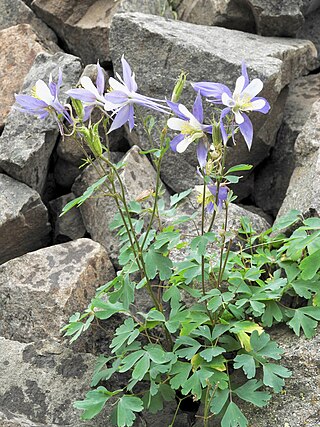
Aquilegia coerulea, the Colorado columbine, Rocky Mountain columbine, or blue columbine, is a species of flowering plant in the buttercup family Ranunculaceae, native to the Rocky Mountains and some of the surrounding states of the western United States. It is the state flower of Colorado. The Latin specific name coerulea means "sky blue".
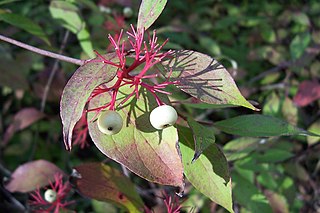
Cornus sericea, the red osier or red-osier dogwood, is a species of flowering plant in the family Cornaceae, native to much of North America. It has sometimes been considered a synonym of the Asian species Cornus alba. Other names include red brush, red willow, redstem dogwood, redtwig dogwood, red-rood, American dogwood, creek dogwood, and western dogwood.

Physocarpus, commonly called ninebark, is a genus of flowering plants in the family Rosaceae, native to North America and northeastern Asia.
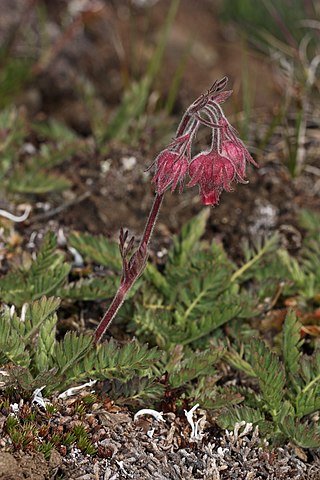
Geum triflorum, commonly known as prairie smoke, old man's whiskers, or three-flowered avens, is a spring-blooming perennial herbaceous plant of the Rosaceae family. It is a hemiboreal continental climate species that is widespread in colder and drier environments of western North America, although it does occur in isolated populations as far east as New York and Ontario. It is particularly known for the long feathery plumes on the seed heads that have inspired many of the regional common names and aid in wind dispersal of its seeds.

Caltha leptosepala, the white marsh marigold, twinflowered marsh marigold, or broadleaved marsh marigold, is a North American species of flowering plant in the buttercup family. The species has regionally distinct variations.

Sedum lanceolatum is a species of flowering plant in the family stonecrop family known by the common names lanceleaf stonecrop and spearleaf stonecrop.

Castilleja septentrionalis is a species of Indian paintbrush known by several common names, including northern paintbrush, sulfur paintbrush, and pale painted cup. There is taxonomic disagreement as to if it is one species widely distributed in mountain and alpine environments of North America or if there is a second species, Castilleja sulphurea, in the Rocky Mountains.

Potentilla villosa is a species of flowering plant in the rose family, Rosaceae. Its common names include villous cinquefoil, northern cinquefoil, and hairy cinquefoil. It is native to northwestern North America, where its distribution extends from Alaska to Alberta to Oregon. There are records from eastern Asia.
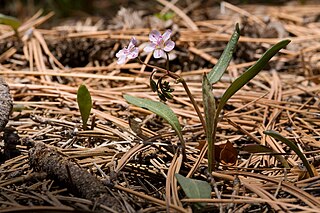
Claytonia rosea, commonly called Rocky Mountain spring beauty, western springbeauty or Madrean springbeauty, is a diminutive spring blooming ephemeral plant with pale pink to magenta flowers. It grows a small round tuberous root and it one of the earliest wildflowers of spring in its range. It is found in dry meadows in forests of ponderosa and Chihuahuan pines, and moist ledges of mountain slopes of the Beaver Dam Mountains of Utah, Colorado Front Range, and Sierra Madre Occidental, south and east to the Sierra Maderas del Carmen of Coahuila.

Mertensia lanceolata, known as prairie bluebells, lance-leaved bluebells, lance-leaved lungwort, and narrow-leaved languid ladies is a species of flowering plant native to the Rocky Mountains and areas of the northern Great Plains in western North America. A herbaceous perennial it has blue-green leaves alternately arranged on its smooth flowering stalk. Its flower buds are pink-purple and become blue as they open.
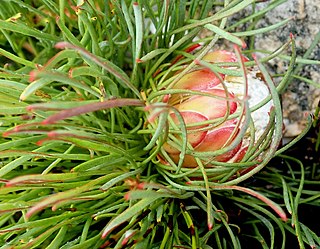
Protea montana also known as the Swartberg sugarbush, is a flowering plant of the genus Protea within the family Proteaceae, which is endemic to the southwestern Cape Region of South Africa. In Afrikaans it is known as swartbergsuikerbos.
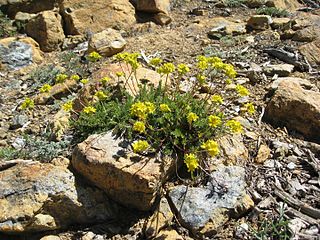
Potentilla tweedyi, also known as Tweedy's mousetail and Tweedy's ivesia, is a species of perennial herb in the rose family. It is native to the Pacific Northwest in the United States, from Washington east to westernmost Montana.
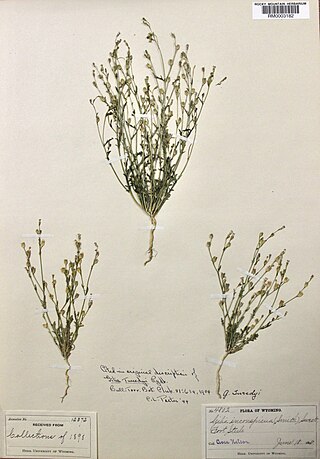
Gilia tweedyi, or Tweedy's gilia, is an annual plant in the phlox family. It is native to the northwestern United States.

Symphyotrichum molle is a species of flowering plant in the aster family (Asteraceae) endemic to the Bighorn Mountains of Montana and Wyoming in the United States. Commonly known as soft aster, it is a perennial, herbaceous plant that ranges from 30 to 60 centimeters in height.

Drymocallis fissa, the bigflower cinquefoil, also known as the leafy cinquefoil, leafy drymocallis, or wood beauty, is a small plant also sometimes classified as Potentilla fissa. It is a herbaceous plant with a thick taproot known for its moderately hairy leaves, redish leaf stems, and relatively large yellow flowers. It is native to foothills and lower mountains the Rocky Mountain region in the western United States.

Castilleja rhexiifolia, commonly called rosy paintbrush, subalpine paintbrush, or rhexia-leaved paintbrush, is a species of plant in Orobanchaceae, commonly known as the broomrape family. They are a common flower found in moist habitats near or above timberline in the Rocky Mountains and the Pacific Northwest. Like most members of the Castilleja genus, they are partially parasitic plants.

Hypericum scouleri, known by the common name Scouler's St. John's wort in English, is a flowering species of plant from western North America. It grows in areas around streams and wetlands from Canada to the highlands of Mexico. It is sometimes mistaken for the invasive Perforate St John's wort from Eurasia.
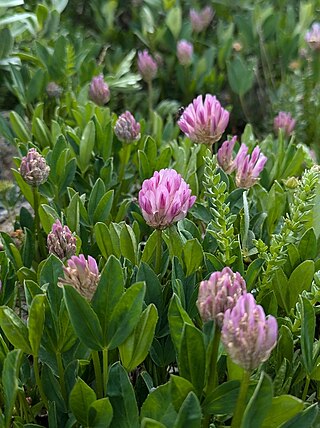
Trifolium parryi, commonly known as Parry's clover or Parry clover, is a high altitude species of plant from the western United States. It grows in the Rocky Mountains from southern Montana to northern New Mexico. It is a short plant that is adapted to the harsh conditions and short growing season near and above timberline.




















